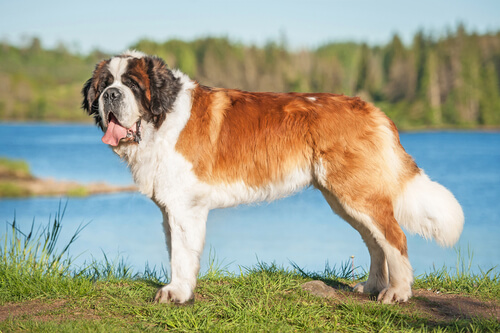
| Kingdom | Animalia |
| Phylum | Chordata |
| Class | Mammalia |
| Order | Carnivora |
| Family | Canidae |
| Genus | Canis |
| Species | C. lupus |
| Species | C. lupus familiaris |
| Niche | Domestic |
| Height | 28-30 in (70-76 cm) |
| Weight | 140-180 lb (65-82 kg) |
| Lifespan | 8-10 years |
| Social Structure | Social, domesticated |
| Breed Status | Popular |
| Preferred Habitat | Domestic |
| Average Litter Size | 2-12 puppies |
| Main Food Item | Dog Food |
The Basics
Saint Bernard is a large breed of domestic dogs originating in Switzerland. Here, native dogs were bred with mastiff-type dogs that arrived with the Roman army. They are large and lumbering and were used as guard dogs and later to help find travelers lost or injured amongst the Alps.
Description
Saint Bernards are descendants of Mastiff-like dogs and inherited their massive qualities, growing to about 12830 in (70-76 cm) tall and 120-180 lb (82 kg). They have two coat varieties: shorthaired and longhaired. The shorthaired variety has a dense and smooth coat and is slightly scruffier on their thighs. The longhaired variety has a coat that is wavey but not so long as to become curly or completely unruly. Both have hair feathering their long tails. Typically their coat is a patchwork of red or reddish-brown with white fur. The red sections are replaced by brindle or brown on some individuals, although this is less stereotypical of the breed. Their ears hang by their side and they have a long, large muzzle and mask-like markings on their faces.
History
Saint Bernards originated in Switzerland alongside other breeds such as the Bernese Mountain Dog which is similar in appearance. They are named after the Saint Bernard Pass which lies at about 8,000 ft (2 430 m) among the Swiss Alps. The Saint Bernard hospice was established late in the 10th century to help travelers navigate this treacherous pass. Here, Saint Bernards were developed not only to guard the hospice but to aid in its primary mission: saving travelers. The large dogs were used to seek out injured or lost travelers, helping to carry or guide them to the hospice where they could find refuge. The first evidence of the breed comes in the form of a painting in 1695 that appears to depict a shorthaired Saint Bernard.

When Saint Bernards reached other countries, breeders selected for different traits such as height and thinness, causing the type to change somewhat. Following the popularity of a Saint Bernard named Plinlimmon who was owned by a traveling actor, the Saint Bernard Club of America was established in 1888. Currently, the Saint Bernard is a common breed, ranking 48th of the 195 breeds currently recognized by the American Kennel Club.
Saint Bernard as Pets
Saint Bernards are popular pets and make excellent companions. However, they are larger than most breeds and require sufficient space to roam when they feel the urge. They do not necessarily need a large outdoor yard to constantly exercise but do require a long walk daily if living indoors. They are notoriously messy, often drooling, shedding, and tracking mud and dirt around with them. Their coats require frequent bathing and brushing. Like most breeds, if not given enough attention, they will become lonely and destructive. Their large size makes this especially true for Saint Bernards.

The size of Saint Bernards can make them intimidating, but they are very affectionate and loving dogs. They want to be near their family and will do their best to become a lap dog despite their lumbering size. They may even be described as docile, but will instinctively protect their family when required. Saint Bernards can be more energetic as a puppy, but most individuals mature into calm and quiet adult dogs that are generally friendly and welcoming.
Although they are particularly gentle, their size may make them poorly-suited for families with young children or any older or particularly frail family members. Saint Bernards are not particularly long-lived, usually about 8-10 years. Females typically give birth to between 2 and 12 puppies in each litter.
Fun Facts about Saint Bernard!
Although there are still Saint Bernards at the Hospice in Switzerland, they are more symbolic than anything else. However, since then Saint Bernards have been seen in various movies as well as successful conformation show dogs. They are also beloved family pets.
Bred From a Warrior
The Saint Bernard was developed by breeding mastiff-like dogs known as Molosser with local mountain dogs. These mastiffs themselves arrived in Switzerland in the time of Augustus with the Roman Army. The Molosser gave rise to many modern breeds, including the English Mastiff and the Saint Bernard. Ironically, the changes that were made to the breed when it was ultimately exported from Switzerland were the result of breeding it again with Mastiffs in England.

The Rescue Dog
Saint Bernards are not for their ability to track down injured and lost travelers in the Swiss mountains where it was bred at the Saint Bernard Hospice. In fact, the breed has been credited with saving more than 2000 travelers over the three centuries over which the hospice operated. The most famous rescue dog ever, Barry, found about 40 people between 1800 and 1810 alone. Today, Saint Bernards are still often used in this way, common members of avalanche rescue teams around the world.
